The top things to do in Zion Park are perfect for nature lovers, adventure seekers, and serenity chasers alike. Tucked away in the dramatic landscapes of Utah, Zion National Park offers a breathtaking mix of towering sandstone cliffs, emerald pools, and winding trails. Whether you’re hiking through the legendary Narrows or gazing at the stars from scenic viewpoints, every moment here feels unforgettable. This guide highlights the best experiences the park has to offer—each one handpicked to help you make the most of your visit. Discover why Zion is one of the crown jewels of America’s national parks!
10 Amazing Things To Do In Zion Park
Experience the best of natural beauty and adventure with our comprehensive list of the best things to do in Zion Park:
1. Conquer Angels Landing
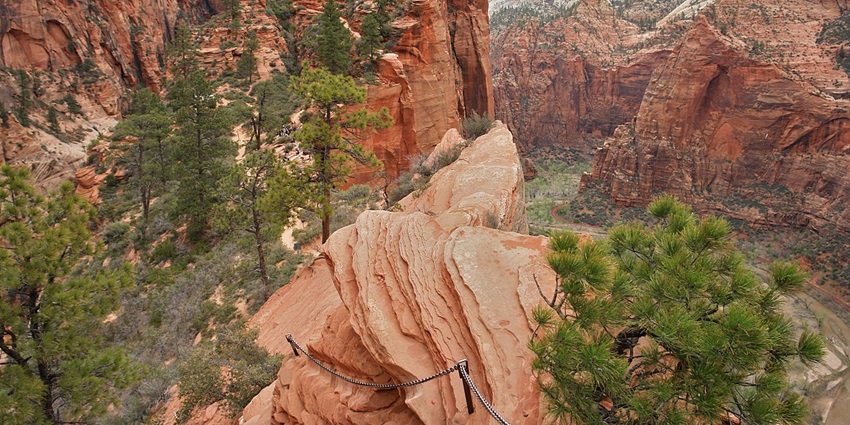
Photo: Alex Proimos / Wikimedia Commons
One of Zion’s most well-known hikes, Angels Landing, offers an exhilarating climb with stunning vistas. Hikers reach Scout Lookout by following the West Rim Trail from The Grotto. Hikers must then traverse a thin ridge for the last half-mile, with safety chains fastened into the rock. The path is only a few feet wide in places, with sheer drop-offs on either side, demanding caution and surefootedness.
Fitness Level: High; suitable for experienced hikers
Ideal For: Adventurers seeking a challenging and rewarding hike
Equipment Needed: Sturdy hiking boots, water, sun protection, and a permit
2. Trek Through The Narrows

Photo: CC0 Public Domain / PxHere
The Narrows provide a distinctive hiking experience via the slot canyons of the Virgin River. Starting from the Temple of Sinawava, hikers wade upstream, surrounded by towering sandstone walls. Approximately 60% of the hike involves walking or swimming in the river, requiring careful navigation over slippery rocks. Proper footwear and equipment are essential, and checking the weather forecast is crucial due to the risk of flash floods.
Fitness Level: Moderate; requires balance and endurance
Ideal For: Those seeking a distinctive river hike
Equipment Needed: Waterproof footwear, walking stick, dry bag, and appropriate clothing
3. Stroll The Riverside Walk
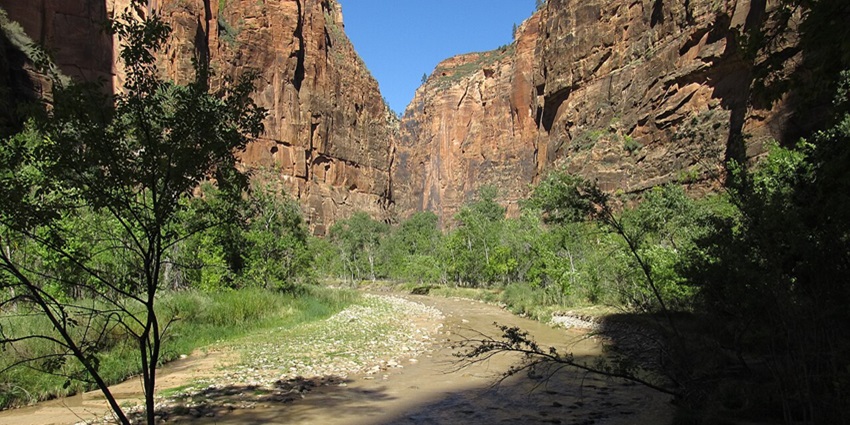
Photo: Ken Lund / Wikimedia Commons
You can reach the Narrows’ entrance by the Riverside Walk, a mild, paved path that parallels the Virgin River. This accessible path is mostly flat, making it suitable for visitors of all ages and abilities. Along the way, interpretive exhibits provide insights into the canyon’s geology, ecology, and history. The trail offers opportunities to observe diverse plant life and possibly spot wildlife. It’s an excellent choice for those seeking a leisurely walk amidst Zion’s natural beauty.
Fitness Level: Low; suitable for all visitors
Ideal For: Families, beginners, and those seeking a gentle hike
Equipment Needed: Comfortable walking shoes and water
4. Explore Emerald Pools
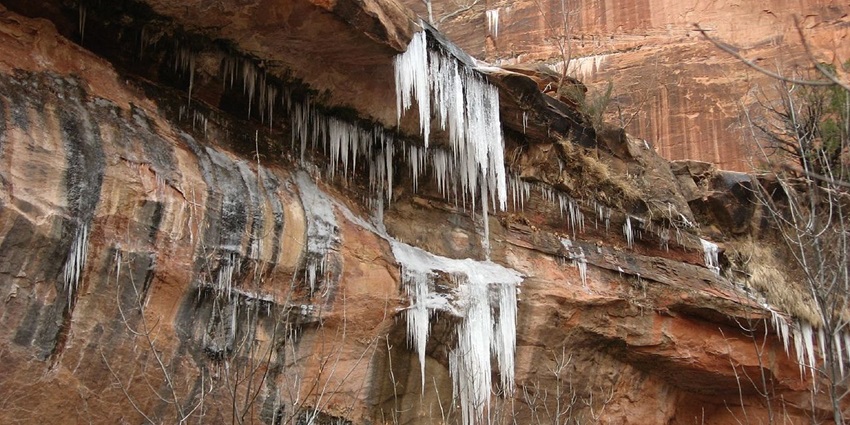
Photo: Ken Lund / Wikimedia Commons
The Emerald Pools trails offer a series of hikes leading to Lower, Middle, and Upper Pools, each showcasing waterfalls and serene pools. These natural vistas are regarded as one of the most beautiful things to see in Zion Park. The Lower Pool trail leads to ephemeral waterfalls over a concrete walk through pinyon-juniper woodland. The Middle Pool hike offers views of the canyon and waterfalls and is a moderate climb.
Fitness Level: Low to moderate; varies by trail choice
Ideal For: Nature enthusiasts and photographers
Equipment Needed: Hiking shoes, water, and sun protection
5. Drive The Zion Canyon Scenic Route

Photo: Tyson Dudley ty_dudley / Wikimedia Commons
Visitors with families wondering what to do in Zion Park should consider a drive through the main route. The Zion Canyon Scenic Drive offers a picturesque journey through the heart of the park. From March through late November, access is via the park’s shuttle system, which connects visitors to major trailheads and viewpoints. The park permits private vehicles on the scenic drive during the off-season. The route provides access to iconic sites such as Angels Landing, The Grotto, and Big Bend, making it an essential experience for visitors.
Fitness Level: Low; suitable for all visitors
Ideal For: Sightseers and those with limited mobility
Equipment Needed: Camera and park map
6. Hike To Observation Point
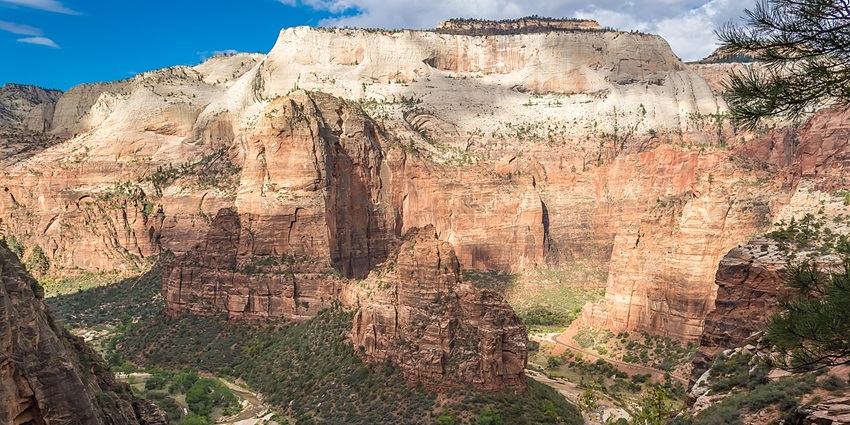
Photo: Lee Coursey / Wikimedia Commons
Observation Point offers one of Zion’s most expansive views, overlooking Zion Canyon and Angels Landing. The trail can be accessed via the East Rim Trailhead, involving a strenuous ascent through diverse terrain, including ponderosa forests and sandstone cliffs. The hike covers approximately 10.6 miles round-trip, with an elevation gain of about 2,100 feet. Due to a rockfall, the traditional route from Weeping Rock is closed, but alternative paths remain open.
Fitness Level: High; requires stamina and preparation
Ideal For: Experienced hikers seeking solitude and views
Equipment Needed: Hiking boots, water, snacks, and sun protection
7. Cycle The Pa’Rus Trail
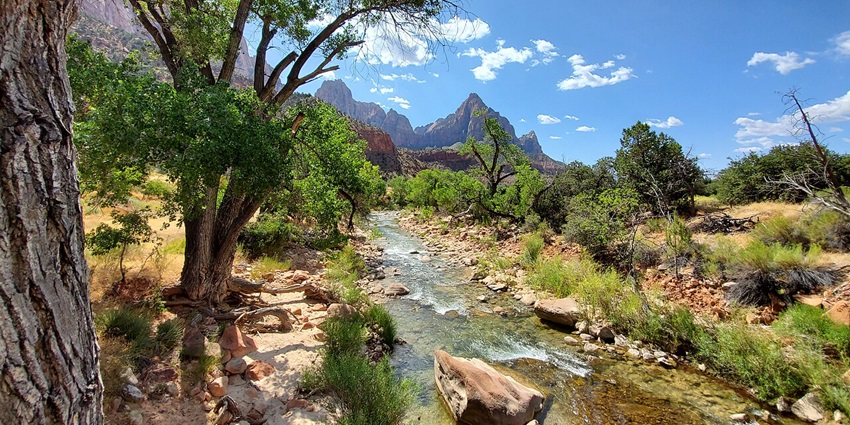
Photo: John Manard / Wikimedia Commons
The Pa’rus Trail is a 1.75-mile paved path connecting the Zion Canyon Visitor Centre to Canyon Junction. It’s open to cyclists, pedestrians, and leashed pets, offering a leisurely ride alongside the Virgin River. The trail provides stunning views of The Watchman and other rock formations. Along the route, there are interpretive signs that provide details on the natural and cultural history of the area.
Fitness Level: Low to moderate; suitable for most cyclists
Ideal For: Families and recreational bikers
Equipment Needed: Bicycle, helmet, and water
8. Visit The Zion Human History Museum

Photo: Ken Lund / Wikimedia Commons
The Zion Human History Museum offers exhibits detailing the park’s cultural and natural history. Displays include artefacts from Native American tribes, early settlers, and the development of the park. The museum also explores the role of water in shaping Zion’s landscape. Seasonal art displays and workshops guided by rangers are available to visitors. The back patio provides a stunning view of the West Temple and the Towers of the Virgin.
Fitness Level: Low; accessible to all
Ideal For: History buffs and educational visits
Equipment Needed: None; optional camera for exhibits
9. Stargaze Under Zion’s Night Sky

Photo: Vikash Singh / Pexels / Image For Representation Only
With its designation as an International Dark Sky Park, Zion National Park provides outstanding chances for astronomy. The park’s low levels of light pollution make clear views of the Milky Way and other celestial phenomena possible. The Pa’rus Trail and the Kolob Canyons are well-known locations for stargazing. Visitors should use red-filtered flashlights to maintain night vision. The park occasionally holds night sky events and astronomy programs.
Fitness Level: Low; accessible to all
Ideal For: Astronomy enthusiasts and romantics
Equipment Needed: Blanket, flashlight with red filter, and star map
10. Explore Kolob Canyons

Photo: Michael Gäbler / Wikimedia Commons
A more sedate option to the main canyon is Kolob Canyons, which is situated in the northwest region of Zion National Park. Reachable from Interstate 15’s Exit 40, the region offers a five-mile picturesque drive with views of imposing cliffs and scarlet valleys. Several trails, such as the Taylor Creek Trail, lead hikers through diverse landscapes and to historical sites. The Kolob Canyons Visitor Centre provides information and exhibits about the area’s geology and history.
Fitness Level: Varies by trail; options for all levels
Ideal For: Those seeking a quieter park experience
Equipment Needed: Hiking gear, water, and a trail map
Zion National Park is a treasure trove of natural wonders, thrilling hikes, and serene landscapes. From scaling dramatic cliffs to wading through narrow canyons, every activity offers a unique glimpse into the park’s majestic beauty. With careful planning and a spirit of discovery, your journey through Zion will leave you inspired and rejuvenated. So lace up your boots, pack your essentials, and let Zion’s magic unfold with TripXL!
Cover Photo: Isaac Martin / Unsplash


 WhatsApp
WhatsApp
 Twitter
Twitter









